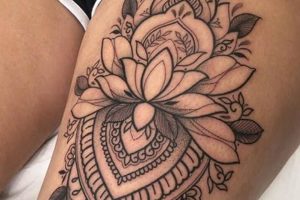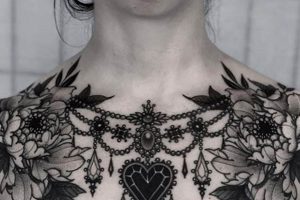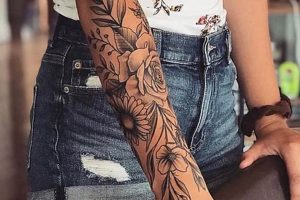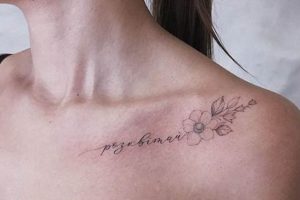Selecting the location for body art is a crucial step in the tattooing process. Placement considers factors such as aesthetics, visibility, pain tolerance, and how the design interacts with the body’s natural contours. For instance, a small, delicate floral design might be well-suited to the wrist or ankle, while a larger, more intricate piece might be better placed on the back or thigh. The chosen location influences the overall impact and personal meaning of the artwork.
Thoughtful placement enhances the aesthetic appeal of a tattoo, ensuring it complements the individual’s physique and style. It allows for discreet or prominent display based on personal preference. Historically, placement has held cultural significance, often reflecting tribal affiliations or social status. Today, it remains a powerful tool for self-expression and storytelling, allowing individuals to showcase their personality and values through carefully positioned body art.
Factors influencing placement decisions include pain thresholds, lifestyle considerations, and the desire for easily concealed or readily visible artwork. Exploring diverse locations such as the ribs, spine, collarbone, or even behind the ear allows for creative expression and personalized artistic statements. The following sections delve deeper into specific placement options and their unique characteristics.
Placement Tips for Body Art
Careful consideration of placement ensures a tattoo complements individual anatomy and personal style. The following tips offer guidance for selecting optimal locations.
Tip 1: Consider Pain Tolerance. Areas with thinner skin and closer proximity to bone, such as ribs, ankles, and feet, tend to be more sensitive. Individuals with lower pain thresholds might prefer fleshier areas like thighs, arms, or back.
Tip 2: Visualize Long-Term Aesthetics. Skin changes with age. Placement on areas prone to stretching or sagging, such as the stomach or lower back, might require touch-ups over time.
Tip 3: Reflect on Lifestyle and Profession. Easily concealed placements are often preferred by those in professions with stricter dress codes. Consider whether visibility is desired or discretion is necessary.
Tip 4: Complement Body Contours. Flowing designs can accentuate natural curves, while smaller pieces can highlight delicate features like wrists or collarbones. Placement should harmonize with the body’s shape.
Tip 5: Think About Clothing and Accessories. Consider how clothing and jewelry might interact with the tattoo. Certain placements might be frequently covered or accentuated by specific garments or accessories.
Tip 6: Research Artist Specialization. Certain artists excel in specific styles or body areas. Researching an artist’s portfolio can help ensure the desired aesthetic and placement are within their expertise.
Tip 7: Consult with a Tattoo Artist. Professional artists offer valuable insights into placement, design, and aftercare. Consultations are crucial for making informed decisions.
Strategic placement enhances both the visual impact and personal significance of body art. Careful consideration of these factors contributes to a satisfying and aesthetically pleasing result.
By understanding the nuances of placement, individuals can make choices that reflect their personal style and ensure a timeless piece of body art.
1. Visibility
Visibility plays a crucial role in tattoo placement decisions. Whether a tattoo is intended for public display or personal reflection significantly influences location choices. This section explores the multifaceted nature of visibility as it relates to body art placement.
- Public Display
Tattoos intended for public display are often placed on areas readily visible in everyday attire. Wrists, forearms, ankles, and even hands are popular choices for those who wish to share their body art openly. This placement can serve as a form of self-expression, a conversation starter, or a means of showcasing artistic taste.
- Discreet Expression
Conversely, some individuals prefer tattoos that can be easily concealed. Ribs, back, thighs, and feet offer locations that are generally covered by clothing. This allows for personal expression without the permanence of constant visibility, providing flexibility depending on social or professional contexts.
- Occasional Visibility
Certain placements offer a balance between public and private display. The back of the neck, shoulders, or upper back can be easily concealed or revealed depending on clothing choices. This allows individuals to control the visibility of their tattoos, adapting to different situations and environments.
- Personal Significance
Even for highly personal and less visible tattoos, the placement itself can hold significance. A tattoo on the inner wrist, for example, might be less visible to others but readily apparent to the individual. This placement allows for a constant, personal reminder of the tattoo’s meaning, serving as a private source of inspiration or comfort.
Ultimately, the desired level of visibility heavily influences placement choices. Careful consideration of personal preferences, lifestyle, and the intended message of the tattoo ensures a placement that aligns with individual needs and aesthetic goals.
2. Pain Level
Pain tolerance is a significant factor influencing tattoo placement decisions. Areas with thinner skin, more nerve endings, or proximity to bone generally experience higher pain levels. These areas include ribs, ankles, feet, armpits, groin, hips, nipples, and elbows. Conversely, fleshier areas like thighs, outer arms, calves, back, and shoulders tend to be less sensitive.
Understanding pain levels associated with different locations allows individuals to make informed choices. Someone with a lower pain threshold might opt for a less sensitive area for their first tattoo. For larger pieces requiring longer sessions, placement on a less painful area can contribute to a more comfortable experience. Conversely, individuals with higher pain thresholds might prioritize the aesthetic impact of a specific location, accepting the associated discomfort. For example, the ribs are a popular location for visually striking tattoos despite being known for higher sensitivity.
Researching pain level charts and discussing anticipated discomfort with a tattoo artist helps manage expectations. Preparation strategies such as adequate rest, hydration, and avoiding alcohol or caffeine before the appointment can contribute to a smoother experience. Ultimately, considering pain tolerance alongside aesthetic preferences contributes to a more positive and informed tattooing experience. Prioritizing open communication with the artist regarding pain management ensures a comfortable and successful outcome.
3. Body Contours
Body contours play a crucial role in the aesthetic impact of a tattoo. Placement that complements the body’s natural lines and curves enhances the design’s flow and overall visual appeal. Strategic placement considers how the tattoo interacts with the individual’s physique, creating a harmonious and visually pleasing result.
- Accentuating Curves
Placement along the collarbone, spine, hips, or thighs can accentuate the body’s natural curves. Designs that follow these contours create a sense of fluidity and elegance. For example, a vine tattoo winding along the spine or a floral design tracing the hipline can enhance the body’s natural shape.
- Highlighting Specific Features
Smaller tattoos can draw attention to specific features. A delicate design on the wrist, ankle, or behind the ear can highlight these areas elegantly. Similarly, a tattoo placed near the shoulder blades can emphasize the back’s structure.
- Creating Visual Balance
Placement can create visual balance and proportion. A larger tattoo on the back can be balanced by smaller, complementary designs on the arms or legs. Careful consideration of scale and placement ensures a harmonious overall composition.
- Consideration of Movement
Placement should consider how the tattoo appears during movement. Designs on areas like the ribs or side of the torso can expand and contract with breathing, adding a dynamic element to the tattoo. This consideration adds another layer of artistic expression.
By considering body contours, individuals can select placements that enhance both the aesthetic appeal of the tattoo and the individual’s physique. This thoughtful approach ensures a harmonious integration of body art and personal form, creating a visually compelling and personalized statement.
4. Lifestyle
Lifestyle significantly influences tattoo placement decisions. Career paths, hobbies, and social environments play a crucial role in determining appropriate and practical locations for body art. Individuals in professions with strict dress codes often opt for easily concealed placements, allowing for self-expression without jeopardizing professional image. For example, teachers, lawyers, or medical professionals might choose locations easily covered by clothing, such as the back, ribs, or thighs. This allows them to express their personal style while maintaining professionalism in the workplace.
Active lifestyles also influence placement choices. Individuals participating in sports or activities involving frequent sun exposure might avoid areas prone to rubbing or friction from clothing or equipment. For instance, a swimmer might avoid placements on areas frequently covered by swimwear, opting for locations less exposed to chlorine and sunlight. Similarly, someone who practices yoga or dance might consider the impact of stretching and movement on the tattoo’s appearance over time, choosing placements that accommodate body flexibility and minimize distortion.
Social environments also factor into placement decisions. Individuals who value discretion might choose locations easily concealed in most social settings, allowing them to control when and where their body art is visible. This allows for personal expression while navigating diverse social situations with varying levels of acceptance towards visible tattoos. Understanding the interplay between lifestyle and placement ensures the tattoo remains a positive and empowering form of self-expression, aligning with individual circumstances and personal preferences. Careful consideration of these factors leads to a harmonious integration of body art into one’s life, reflecting personal style without compromising professional or social dynamics.
5. Personal Style
Placement choices for body art reflect individual style and preferences. From minimalist designs to intricate artwork, placement considerations align with personal aesthetics and desired levels of visibility. This section explores how personal style influences placement decisions, creating a harmonious blend of body art and individual expression.
- Minimalist Aesthetics
Individuals drawn to minimalist aesthetics often prefer small, discreet tattoos placed on delicate areas like wrists, ankles, or behind the ear. These placements complement understated jewelry and clothing styles, reflecting a preference for subtle elegance. Small geometric shapes, single words, or delicate line art are common choices, emphasizing simplicity and clean lines.
- Bohemian Influences
Bohemian styles often incorporate nature-inspired designs, flowing lines, and intricate patterns. Placements on the back, ribs, or along the spine allow for larger pieces that complement flowing clothing and a free-spirited aesthetic. Floral motifs, mandalas, or dreamcatcher designs are popular choices, reflecting a connection to nature and spirituality.
- Maximalist Expression
Maximalist styles embrace bold statements and intricate designs. Larger-scale pieces on areas like the thighs, arms, or chest allow for detailed artwork and vibrant color palettes. Portraits, full sleeves, or complex geometric patterns are common choices, reflecting a desire for impactful and visually striking body art.
- Professional Considerations
Personal style also considers professional contexts. Individuals in more conservative professions might opt for easily concealed placements, allowing for self-expression while maintaining professionalism. Smaller tattoos on the feet, ribs, or back offer discreet options, allowing individuals to express their personal style without compromising workplace appropriateness.
Ultimately, placement decisions are deeply personal, reflecting individual aesthetics, lifestyle, and desired level of self-expression. Understanding the interplay between personal style and placement choices ensures a harmonious integration of body art, creating a visually compelling and personally meaningful statement.
6. Symbolic Meaning
Symbolic meaning adds depth and personal significance to tattoo placement. The location of a tattoo can amplify its intended message, creating a powerful connection between the artwork and the individual’s body. Placement choices often reflect personal experiences, beliefs, or values, transforming body art into a deeply meaningful narrative.
For instance, a tattoo placed over the heart can symbolize love, loss, or remembrance of a loved one. A bird tattoo on the wrist might represent freedom or a yearning for independence. A lotus flower on the shoulder could symbolize resilience, growth, and overcoming adversity. These symbolic connections enhance the tattoo’s personal resonance, transforming it from mere decoration into a powerful expression of self.
Cultural and historical symbolism also influences placement choices. Specific symbols hold different meanings across cultures, and understanding these nuances can inform placement decisions. For example, a dragon tattoo might represent power and wisdom in some cultures, while in others, it symbolizes protection or good fortune. Researching the cultural significance of chosen symbols ensures the tattoo’s message aligns with intended meaning and avoids unintended interpretations.
Furthermore, placement can create a private dialogue between the individual and their body art. A tattoo placed on an area not readily visible to others can serve as a personal reminder of a significant event, belief, or mantra. This intimate placement fosters a deep connection between the individual and their tattoo, imbuing it with personal meaning and significance.
By considering symbolic meaning alongside aesthetic preferences, individuals create tattoos that resonate on a deeper level. This thoughtful approach transforms body art into a powerful form of self-expression, storytelling, and personal commemoration.
Frequently Asked Questions
This section addresses common inquiries regarding selecting appropriate tattoo locations.
Question 1: How does one determine the most suitable placement for a tattoo?
Optimal placement considers factors such as pain tolerance, lifestyle, desired visibility, body contours, and the tattoo’s symbolic meaning. Consulting with a professional tattoo artist is highly recommended.
Question 2: Which locations are generally considered less painful for tattooing?
Fleshier areas like thighs, outer arms, calves, and back tend to be less sensitive. Areas with thin skin or close proximity to bone, such as ribs, ankles, and feet, are typically more sensitive.
Question 3: How might a tattoo’s placement affect its appearance as the body ages?
Skin elasticity changes over time. Placement on areas prone to stretching or sagging, such as the stomach or lower back, may require touch-ups to maintain the tattoo’s integrity.
Question 4: Are there specific placements recommended for easily concealed tattoos?
Easily concealed locations include the back, ribs, thighs, feet, and upper arms. These areas are typically covered by clothing, allowing for discretion in professional or social settings.
Question 5: Can tattoo placement enhance the symbolic meaning of the design?
Placement can significantly amplify symbolic meaning. A tattoo over the heart, for instance, can represent love or remembrance, while a bird on the wrist might symbolize freedom. Placement can imbue a tattoo with deeper personal significance.
Question 6: What is the importance of consulting with a tattoo artist regarding placement?
Professional tattoo artists offer invaluable expertise in design, placement, and aftercare. They can provide personalized guidance based on individual anatomy, desired aesthetic, and lifestyle considerations, ensuring informed decisions and optimal results.
Careful consideration of these frequently asked questions empowers individuals to make informed decisions regarding tattoo placement, resulting in body art that reflects personal style, values, and aesthetic preferences.
This concludes the FAQ section. For further inquiries or personalized guidance, consult a reputable tattoo artist.
Conclusion
Careful selection of tattoo placement is crucial for achieving desired aesthetic and personal expression. Factors such as pain tolerance, lifestyle considerations, body contours, and symbolic meaning contribute significantly to a successful outcome. Understanding the interplay of these elements empowers informed decisions, ensuring the chosen location complements both the design and the individual’s unique form. Visibility preferences, ranging from discreet locations to prominent displays, further personalize the tattoo experience, allowing body art to serve as a powerful form of self-expression and storytelling.
Body art serves as a permanent form of self-expression, reflecting individual narratives and aesthetic sensibilities. Thoughtful placement elevates this art form, transforming the body into a living canvas where personal stories unfold. Careful consideration of placement ensures a harmonious blend of art and anatomy, creating a lasting testament to personal style and individual expression.







